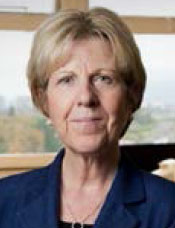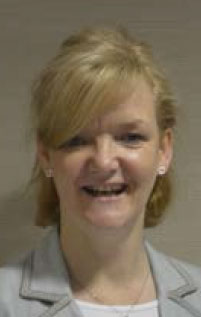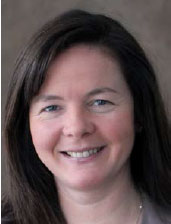Nursing and midwifery care: event report
A report of Scotland's first assuring nursing and midwifery event.
Excellence in Care: Presentations

Professor Rosslyn Crocket
Work on assuring all aspects of nursing and midwifery care is underway in Scotland's NHS boards. The next three stories highlight initiatives in five board areas (one tri-board approach and two individual) that are examples of those being taken forward across Scotland. The presentations allowed participants to understand the different elements of the assurance work and how it all fits together.
Tri-board Model Making Progress
Three NHS boards have joined forces to introduce a care assurance and accreditation scheme (CAAS) adapted from a model introduced in England.
NHS Greater Glasgow and Clyde, NHS Lanarkshire and NHS Ayrshire & Arran have been working on CAAS for the last two years. NHS Greater Glasgow and Clyde Executive Nurse Director Rosslyn Crocket told participants that it was about providing an environment from which staff can offer good care on an ongoing basis.
"Our starting point was to ask what we could do as organisations to make things better for our staff and support them to provide the kind of care we know they want to deliver," she said. "It wasn't that we were unhappy about the care given, but we knew we hadn't got it quite right, so we wanted to introduce a system, an opportunity and a culture in which staff could do the right thing every time."
The three board nurse directors got together to discuss problems that had been highlighted by external inspections. Following a review of the literature, Salford Royal Hospital Trust's Nursing Assurance and Accreditation Framework was chosen as an appropriate model. Senior charge nurses and midwives from the boards met with matrons from Salford to explore the framework's potential - with hugely positive results.
"The enthusiasm, motivation and buy-in from our staff was palpably high," Professor Crocket said. "They told us the system was putting everything together in a single framework and recognised that it was describing what they should be doing."
The approach is person-centred and focuses on the organisation supporting staff to deliver high-quality care. "It is not a performance-management approach - it's about continuous improvement support for staff," Professor Crocket said.
The care standards from Salford were adapted to reflect the Scottish context and tested across the three boards, which had its challenges.
"It wasn't easy to get complete harmony across the boards," Professor Crocket conceded. "We are now at version nine of our standards, which gives an idea of the iterative process we have gone through."
The standards, which cover six specialist areas including acute care, mental health and maternity, are benchmarked against important documents like the Vale of Leven Hospital Inquiry Report and are signed off by frontline staff and a tri-board steering group. Identified nurses at ward level have responsibility for supporting their teams to deliver each standard, which helps to ensure consistency.
While CAAS is nurse led, the steering group has multidisciplinary representation and a patients' panel has been formed to ensure their voice is heard. But Professor Crocket believes top-level support has been crucial to its success so far.
"Our approach to improving frontline care is included in our Chief Executive's objectives for this year and those of every senior manager," she said. "It's very much an organisational approach to changing the way we do things, helping the whole nursing team to get things right and supporting them - not criticising them - when things don't go so well."
Also crucial is engagement with frontline staff. "We need to hear what frontline staff are saying and thinking," she said. "They are the people delivering the care and their perceptions are vital. And when they tell us something, we need to have a system to ensure we feed back to them quickly on what action we will take."

Anne Marie Cavanagh
Quality at the Heart of the Golden Jubilee
Having robust governance arrangements in place at board level is not necessarily a guarantee of high-quality care delivery, Golden Jubilee National Hospital Executive Nurse Director Anne Marie Cavanagh told participants.
"Quality care is not an accident," she said. "It is about conscious intent to make things better for patients, and that has to involve everyone in the organisation."
The hospital started an exercise four years ago that aimed to increase understanding of staff members' vision for, and expectations of, the care they delivered. A series of ongoing surveys and focus groups since then have revealed the issues that are important to staff.
"It was important to move away from a top-down approach to find out what staff actually felt," Ms Cavanagh explained. "We now have insight into what matters to them when they come to work each day - things like promoting dignity and respect, adopting a 'can-do' attitude, understanding their and others' responsibilities and working effectively as a team. These are now the values that are driving the organisation."
The Quality Strategy ambitions of person-centred, safe and effective care for everyone have been embedded throughout the organisation, from ward to board.
"It was about bringing the Quality Strategy outcomes to life for people and helping them to see how useful they are in guiding their work and the work of the whole organisation," she said. "We use the Quality Strategy outcomes as a template to govern what we do, whether it be setting budgets and addressing waiting times, assessing staff values and performance, or monitoring patient care indicators. It presents a very different way of looking at what goes on in the organisation."
Central to this is the idea of a values-based workforce. "Frontline staff are guardians of quality in patient care," Ms Cavanagh explained. "This means they are encouraged and expected to challenge nurse management when they believe the environment is not conducive to high-quality care and know how to respond when confronted with poor care or inappropriate behaviour. We want staff to be able to see, feel and believe in quality in whatever they do."
Various staff development and support programmes have been introduced to further embed the values-driven approach, including a leadership recruitment programme. A suite of care assurance systems, including the Caring Behaviours Assurance System (CBAS), is also being deployed, with relevant training available to multidisciplinary staff of different grades.
Dashboards for staff values, clinical care and key targets have been introduced. "The dashboards reflect data we were already collecting, but make it much more accessible to everyone," Ms Cavanagh explained. "They are hosted on the hospital intranet and can be accessed on PCs in the wards and on monitors outside the wards to enable the public and patients to gauge progress. They are also accessible to board executive and non-executive directors."
"The dashboard for the public was simplified following consultations with patients and the public-patient focus group," she continued. "It now asks simple questions and provides simple answers. Having access to the information opens ward staff to challenges from patients and visitors, and we are supporting staff to be able to have these conversations without needing to defer constantly to the senior charge nurse."
While the quality measures the hospital has taken are resulting in very positive feedback from patients and low levels of turnover, grievances and sickness from staff, Ms Cavanagh said there was no room for complacency.
"We are on a journey, and there is still some way to go," she said. "We are now very interested to see how a national care assurance system can be mapped across to what we are already doing in the organisation."

Professor Angela Wallace
Looking Back to Look Forward
In looking forward, NHS Forth Valley has looked back to review the fundamentals of care provided, Executive Nurse Director Angela Wallace told participants.
The aim at the start of the NHS Forth Valley journey, around seven years ago, was to use patient experience to convince people of the difference nurses could make. The hypothesis was that support for senior charge nurses and their teams was key to improving care and experiences for patients.
"We were trying to be reliably consistent about the standard we wanted to achieve," Professor Wallace said. "We've used a balance approach - it isn't just about standards, it's also about patient and staff experience, management of resources, upskilling staff and improving staff numbers to ensure they can answer whatever is asked of them. We are still on the journey, but progress is undeniable."
The passion to ensure nursing and midwifery can answer whatever is asked has been central to the approaches adopted over the years.
"This quest has driven our nursing and midwifery objectives at organisational level and is continuing to inspire the ambitions of individual nurses, midwives and teams," Professor Wallace said. "We want the NHS Forth Valley nursing and midwifery brand to be the best in the world - we're not there, but we want to aim for something that really tests us."
A balanced scorecard for senior charge nurses was one of the first initiatives introduced. "We felt if we could get the senior charge nurse role right and asked them to focus on very clear deliverables, we would know exactly where we were with nursing care," she explained. "The scorecard developed further as Leading Better Care was introduced and was integrated with other measures, such as the Clinical Quality Indicators, Releasing Time to Care and the Scottish Patient Safety Programme. This meant that from the senior charge nurse perspective, they had only one ask - the balanced scorecard."
The system is owned by the senior charge nurses and provides them with instant feedback on progress. The scorecard now represents the four key elements of the senior charge nurse role as defined in Leading Better Care, so they can see not only data regarding clinical care delivery, but also information on patient experience, team management and contributions to organisational objectives. A traffic light system is used to highlight areas of success and concern.
Care assurance is managed through the Assuring Better Care (ABC) system, a visible leadership walk-round process.
"Heads of nursing spend an entire day in the wards and departments once a month, testing and verifying the data supplied in the balanced scorecards and speaking to patients, visitors and staff," Professor Wallace explained. "Care assurance is provided by assessing against indicators for issues such as infection control and tissue viability, standards of care and professional practice. Feedback to charge nurses is immediate via an app on mobile devices, and any areas of concern are highlighted in the scorecards as a focus for improvement."
The care indicators used in the scorecards and the walk-rounds have been augmented to ensure that key elements of person-centredness are reflected. "Indicators on infection control rates and numbers of falls are very important, but they don't provide us with information about the tone of the care provided and the demeanour of the nurses delivering it," Professor Wallace observed. "We therefore also include indicators about patient and staff experience, documentation and end-of-life care."
The ABC system provides Professor Wallace and her nursing and midwifery team with real-time data on key areas of practice across the health board at the touch of a button. "It means that whatever staff are worrying about, I'm worrying about it too, and together we can find solutions," she said.
Professor Wallace explained that when she took up post as nurse director, she had very few measures to assure the quality of care. "The only real measure I had was if a ward or team failed," she said. "The system now is about trying to identify issues early to avoid them leading to serious failures of care, whether in an individual ward or department or across the system, keeping everyone 'above the line'.
"It also means we avoid relying on the assumption that things are being done when actually they are not," she continued. "The ABC system shows us what is really happening. It is rooted in improvement and drives a culture in which people are not afraid of inspection and scrutiny - in fact, they welcome it."
Contact
Email: Jan Liddle
There is a problem
Thanks for your feedback